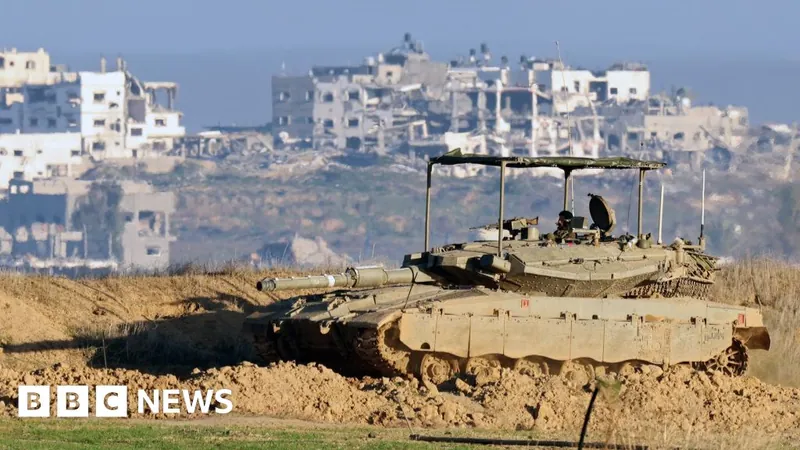
Gaza Ceasefire: Hopes and Challenges Ahead!
2025-01-15
Author: Ting
Gaza Ceasefire: Hopes and Challenges Ahead!
In a potentially historical development, Israel and Hamas are reportedly on the verge of reaching a ceasefire agreement that could not only halt the ongoing conflict in Gaza but also facilitate the release of hostages held by both sides. According to sources from CBS, backed by insights from Arab, US, and Israeli officials, an agreement has been tentatively established and could be finalized within this week.
This upcoming ceasefire marks a significant milestone in a 15-month-long conflict initiated by Hamas's surprise assault on Israel in October 2023. The hope is that this deal will serve as a turning point in the relentless warfare that has tragically reshaped the lives of millions in Gaza.
Key Aspects of the Ceasefire Agreement
1. **Hostage and Prisoner Exchange**: Central to the negotiations is the fateful exchange of hostages. Initially, Hamas captured 251 individuals during its October onslaught, and as of now, 94 remain in captivity, with Israeli authorities estimating that only 60 might still be alive. In return, Israel is prepared to release approximately 1,000 Palestinian prisoners, with many having faced years of incarceration.
2. **Phased Implementation**: The ceasefire is proposed to unfold over three stages: - **Stage One**: A swift release of three hostages, with a subsequent exchange of 30 more for Palestinian prisoners taking place over several weeks. This initial phase will also see Israeli troops begin to withdraw from civilian areas in Gaza. - **Stage Two**: In this phase, remaining hostages — predominantly soldiers and reservists — would be released as part of a further prisoner swap. It’s significant to note that among those 1,000 Palestinian prisoners, around 190 are serving lengthy sentences for serious offenses, but those convicted of murder are expected to be kept from returning to the occupied West Bank. - **Stage Three**: This will involve the long-term reconstruction of Gaza, a process anticipated to span years. Despite the ceasefire, Israeli security forces are expected to maintain a presence in buffer zones within Gaza for the foreseeable future.
The Road Ahead: Challenges and Opportunities
Negotiations to reach this agreement have been complex and drawn out, reflecting the deep-seated mistrust between Hamas and Israel. Each side has had its own set of non-negotiable demands, complicating the possibility of a lasting peace. While Hamas has sought a complete halt to hostilities before any potential prisoner exchanges, Israel has remained steadfast in its military objectives, aimed largely at dismantling Hamas's military and governance capabilities.
Despite these proposed steps towards peace, the situation remains precarious. The fragility of any ceasefire between the two adversaries is underscored by the history of previous agreements being disrupted by sporadic violence. Moreover, the question of whether the hostages can be accounted for remains uncertain, with discrepancies over their conditions and whereabouts adding to the tension.
Is This the End of the Conflict?
While there is hope that this ceasefire may bring a respite from the horrors of war, it is essential to remember the dynamics at play. The stakes are high, as significant strides have yet to be made towards mutual trust and substantive peace negotiations. The potential for further skirmishes looms large, and as the world watches, many are left to wonder if this momentary pause could lead to a more permanent resolution—or if it will merely be another chapter in a long saga of conflict.
Stay tuned as we monitor developments closely, and brace yourself for what could be a defining moment for stability in the region!


 Brasil (PT)
Brasil (PT)
 Canada (EN)
Canada (EN)
 Chile (ES)
Chile (ES)
 Česko (CS)
Česko (CS)
 대한민국 (KO)
대한민국 (KO)
 España (ES)
España (ES)
 France (FR)
France (FR)
 Hong Kong (EN)
Hong Kong (EN)
 Italia (IT)
Italia (IT)
 日本 (JA)
日本 (JA)
 Magyarország (HU)
Magyarország (HU)
 Norge (NO)
Norge (NO)
 Polska (PL)
Polska (PL)
 Schweiz (DE)
Schweiz (DE)
 Singapore (EN)
Singapore (EN)
 Sverige (SV)
Sverige (SV)
 Suomi (FI)
Suomi (FI)
 Türkiye (TR)
Türkiye (TR)
 الإمارات العربية المتحدة (AR)
الإمارات العربية المتحدة (AR)